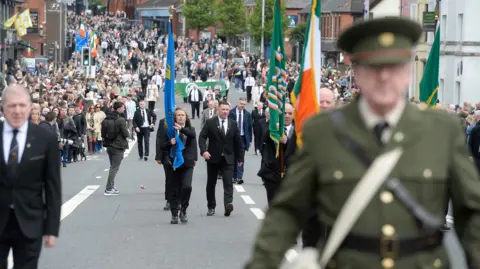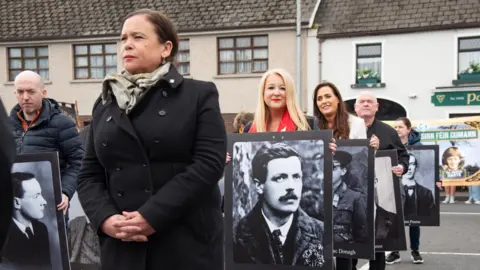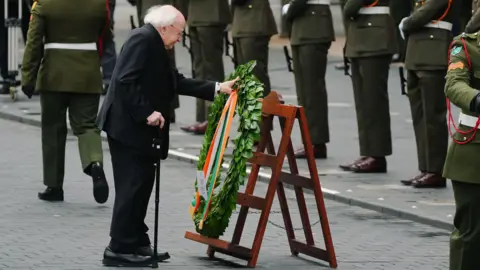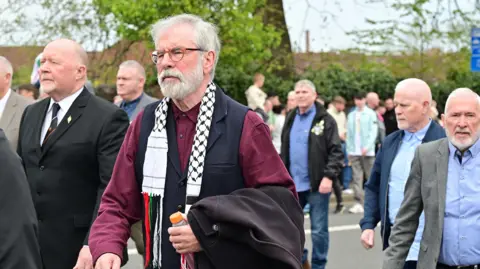Easter parades held to commemorate 1916 rising
 PA Media
PA MediaEvents and parades have been held across Northern Ireland and the Republic of Ireland to commemorate the Easter Rising.
The 1916 rebellion was an attempt to overthrow British rule in Ireland and has been credited by many historians as paving the way towards an independent Irish republic.
In Dublin, the Irish President Michael D Higgins laid a wreath outside the General Post Office (GPO) to commemorate those who died in the rebellion before a minute's silence was observed.
In Belfast a large crowd gathered for a parade along the Falls Road.
Speaking at a gathering in Carrickmore, County Tyrone, Mary Lou MacDonald said that her party was "intent to finish the business of 1916".
 Pacemaker
PacemakerThe Sinn Féin leader told those gathered that they must prepare for Irish unity.
"The conversation is live - we must prepare for unity referendums in this decade.
"We must prepare to win these referendums and win them well."
McDonald said that her message to unionist was that Irish unity is "about everyone".
"The United Ireland we seek belongs every bit as much to the families of Dungannon, to families on the Shankill, to the families of Carrickmore - to every family in Tyrone - and to the families of Dublin, Cork and Galway."
 Pacemaker
PacemakerMcDonald told the crowd that maybe it was always meant to be that the first nationalist to lead the Northern Ireland Executive is a woman from Tyrone:
"Michelle O' Neill is a first minister for all who is determined to make politics work for everyone.
"27 years after the Good Friday Agreement the north is a very different place.
"We see this in the advancement of Irish language rights," she said.
 PA Media
PA MediaO'Neill was among those who attended the ceremony in the Irish capital.
Speaking ahead of the event, President Higgins said the men and women who participated in the 1916 Rising were "inspired by the declaration of a Republic, and the dream of a better, fairer future".
"The Proclamation of the Republic, which Patrick Pearse read out from under the portico of the GPO, offers elements of a generous social and political vision that can still inspire us," he said.
At Sunday's event, the 1916 Proclamation of Independence was read by Captain Conor Gibbons from the Defence Forces HQ in Kildare.
On Saturday, O'Neill attended her first republican Easter commemoration in Northern Ireland since taking up office as first minister.
 Pacemaker
PacemakerMeanwhile, Sinn Féin TD (member of the Irish parliament) Pearse Doherty and former party leader Gerry Adams were among those participating in events in Belfast on Sunday.
In the Belfast parade, some observers placed wreaths while others carried portraits of some of those involved in the Rising.
A flute band played as part of the procession.
What was the Easter Rising?
The Easter Rising was a rebellion designed to overthrow British rule in Ireland.
It was organised and carried out by members of the Irish Republican Brotherhood, the Irish Citizen Army, and Cumann na mBan, or the 'League of Women'.
Shortly after noon on Easter Monday 1916, Pádraig Pearse accompanied by an armed guard, stood on the steps of the GPO and read a proclamation declaring the establishment of an Irish republic, signalling the beginning of the Easter Rising.
The conflict that followed was largely confined to Dublin.
The Easter Rising was quelled within six days by British troops, but despite its failure it is seen as a significant stepping stone to the eventual creation of the Republic of Ireland and the partition of Ireland.
More than 450 people were killed and 2,500 injured during the fighting.
In the aftermath of their surrender to British troops in 1916, 14 rebel leaders were executed by firing squad in the stonebreakers' yard at Kilmainham Gaol.
Two other rebel leaders were executed elsewhere - Thomas Kent was shot dead by firing squad in Cork and Roger Casement was hanged at Pentonville Gaol in London.
The manner of their deaths is seen by many historians as instrumental in changing public opinion in Ireland in 1916 - which was initially hostile to the rebellion - into sympathy and support for the republican push for independence.
